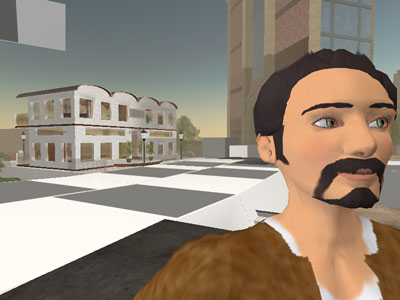Brown, I’d prefer you didn’t
I just remembered something that made me laugh a while back. I was talking to a friend of a friend who works for UPS. We were joking about the tagline “What can brown do for you?” when he told me about an internal effort to galvanize support for the new campaign. The execs were trying to think of something catchy when someone suggested “Operation Brownstorm.” This stuck. As a storm of brown might.
The teams, I was told, couldn’t believe that management would go with such a blatantly scatological reference. Not only that but employees were encouraged to “Get behind Operation Brownstorm!” Um, no thank you. I’ll stay right out here in front. A safe distance from the squall.
Lesson: when Googling for name inspiration be sure to deselect the mature content filter.
UPDATE: If you want to mount an awareness effort on the color brown, you might have a look at the Chicago Transit Authority’s Countdown to a New Brown. There’s built-in potty humor there too, of course, but no storming as far as I can tell.
In which I offer a series of exciting thoughts on punctuation in the 21st century
Just finished a delightful little book on punctuation. No, really I did. The central theme of the book — hey, you should care about punctuation because, if you don’t, what you mean to say can run off the rails — is made through a variety of humorous reflections on individual punctuation marks. (The author, Lynne Truss, would have a real problem with my use of the dashes above, for instance. And probably my love affair with the parenthesis for that matter.)
The final chapter deals with the effects of computer-mediated communication and the Internet on punctuation usage. As you’d guess, she’s not impressed.
Anyone interested in punctuation has a dual reason to feel aggrieved about smileys, because not only are they a paltry substitute for expressing oneself properly; they are also designed by people who evidently thought the punctuation marks on the standard keyboard cried out for an ornamental function. What’s this dot-on-top-of-a-dot thing for? What earthly good is it? Well, if you look at it sideways, it could be a pair of eyes.
Clearly the emoticon is less like punctuation and more a crude surrogate for emotive language. But I think there is one aspect of computer-based writing that does deserve consideration as a new kind of punctuation: the hyperlink. By those who love the link it is usually treated as a technical feature or a design aspect. To those decrying the end of the book (and thus the end of critical thinking and thus the end of civilization) it is seen as a roadblock to sustained argument and reason. But people get too hung up on the fact that the link leads somewhere. In fact, the hyperlink really does act like punctuation, regardless of where the link takes you.
Consider how many links you encounter in prose that you do not click. Hundreds if not thousands daily. Clearly they change the structure of the sentence, whether you click on them or not. So what is the effect, from a punctuation perspective, of the unclicked link? Well, it isn’t a pause or a full stop so that means it isn’t like a comma, semi-colon, or period. (Stay with me people, this is interesting.) Assuming it is visually different from normal text, the unclicked link is more akin to a colon whose job it is to introduce some thought clearly related to what precedes it. Truss describes it so:
… [the colon] rather theatrically announcnes what is to come. Like a well-trained magician’s assistant, it pauses slightly to give you time to get a bit worried, and then efficiently whisks away the cloth and reveals the trick complete.
The link is a multi-dimensional colon. Oh, it announces what’s to come alright, but what’s to come doesn’t exist on the same plane as what you were just reading.
The link also performs a role similar to parentheses, brackets, em-dashes, and even quotation marks. The unclicked link, in short, suggests structured meaning in prose without actually conveying an idea the way words do — which of course is exactly what punctuation does. You might say, well the link is just a fancy kind of footnote. But that too focuses too much on the function of the footnote after you’ve followed it where it leads and not on how it operates semantically in the context of the sentence. The footnote superscript is punctuative (whoa, Googlewhack candidate alert) in that it says “hey, this is important enough to require commentary.” Even if you don’t travel down the page or to the endnotes this extra bit of meaning has been conveyed by the superscript. Same with the link. It is a call-out, evidence however slight that there’s elaboration, example, or extra material nearby.
In his book Interface Culture, Steven Johnson noted the unique use of links by the now-defunct Suck site. I’d argue that the best linking on the web today has mostly caught up with the style pioneered by Suck.
The rest of the Web saw hypertext as an electrified table of contents, or a supply of steroid-addled footnotes. The Sucksters saw it as a way of phrasing a thought. They stitched links into the fabric of their sentence, like an adjective vamping up a noun, or a parenthetical clause that conveys a sense of unease with the main premise of the sentence. They didn’t bother with the usual conventions of “further reading”; they weren’t linking to the interactive discussions among their readers; and they certainly weren’t building hypertext “environments”. … Instead, they used links like modifiers, like punctuation – something hardwired into the sentence itself.
What it comes down to is only this: I am getting to the point where I don’t trust online writing that does not contain links. Just like you’re wary of the grocer who sells “apple’s” or the the writer whose sentences run on for miles without a period, I’m increasingly uncomfortable with writing that’s link-free. I may never click the links I encounter, but their presence indicates a structuring of thought that subtly affects how I approach what I am reading. Just like punctuation.
What not to say to a pregnant, exhausted Mom at the end of a day of wrangling two young children
Son: “Mom, what planet has a hurricane on it?”
Mom: (Oh shit.) “Um, Saturn?”
Son: “No mom (duh), Jupiter.”
Mom: “Who taught you that son?”
Son: “Daddy.”
Mom: “Good thing you have such a smart Daddy.”
Son: “Mommy, why aren’t you smart?”
Mom: […]
Update: Hold the presses, Saturn does have hurricanes. Mommy really is smart!
Everyone stand back, I’m a chef
This morning on the L train a woman collapsed at my feet. In my iPod-cocoon I admit I only realized this as I saw commuters’ faces looking at the floor near me. I’ve seen other people faint on the train before (must have something to do with the motion), but this time I was impressed by the reaction of the bystanders. Almost immediately and without a leader to delegate, individual tasks were assumed by the commuters in the immediate vicinity. An off-duty CTA worker jumped on his cell to contact the line operator, the person nearest the intercom alerted the conductor, the woman next to me stooped down to hold the woman’s hand and comfort her, and a doctor knelt down to figure out what was going on.
At least, we thought he was a doctor. I mean, he had a white coat and a badge and looked very authoritative. As I looked closer I saw that the white coat was the double-breasted kind that chefs wear. (He had it unbuttoned which made it look more like a lab coat.) His profession was confirmed by the kooky pants chefs (and bodybuilders and MC Hammer) sometimes wear. What was I going to do, interject “Hey wait a minute this guy’s a chef! And probably a line chef too! Back off, pal!” Would he take her vital signs with his meat thermometer? Dab her sweat with his toque? I just stood back, mentally blogging (hey, I needed a role too) and thought about how both wonderful and somewhat frightening it is that initiative counts for more than expertise in matters of leadership.
We transferred the woman, who we learned was pregnant and probably suffering a blood sugar dip, to trained medical personnel at the next platform.
Vanity googling
One of my resolutions in January was to find my roommate from study abroad in Rome in 1993. I listed his name hoping that it’d get indexed and that at some time in the future he’d Google himself and find that I was looking for him. This is exactly what happened. Some people feel self-conscious about Googling themselves, which is crazy. It is the one sure bet you can make: people will Google their own names (and download naughty things, I suppose). This behavior is so natural that if you have your name on a page with another’s name you can be fairly certain the other will see it at some point in the future. Sort of like posting a note for a person to find out in the wilderness. But found it will be, eventually.
Can you tell what photos of a fan-powered Santa, a stumped computer-user, a truckload of anchovies, and middle-aged Swedes dancing the night away have in common?

They are all returned as image results when Googling my last name. Now, I’ve known for a while that my last name is Icelandic for ‘computer,’ but a majority of the images are of construction equipment or bizarre machinery. The Santa hoverpack? No idea.
Think of it as visual tagging or reverse-steganography. Instead of embedding a secret word in images, you deduce the word from the images themselves. What would be great is a Google image upload feature (akin to typing a keyword) that matched submissions against the database and provided you with shared keyword terms.
Flickr has a tag game sorta like this.
Bathroom ethnography
One of the best things about not travelling is settling back into the warm embrace of routine. There I said it. Though the over-routinized make up a huge part of the IT geek pool and though they suffer my lighthearted mockery for it, I will admit here, now, that there is something to be said positively for having a bit of routine in one’s life. For example, going to the bathroom. Now, this may have something to do with my work in China where toilets aren’t — how to say — well, they aren’t toilets at all. Being back in my office in Chicago reminds me how much I love the facilities here. So, having spent some time getting to know them again, I am reminded that others too have very predictable behaviors, especially as they relate to Human Bathroom Interaction (HBI). Here, then, are the gross (ahem) categories into which I put my colleagues, all male, obviously:
The Bold Enterer – This is the guy who slams the bathroom door open and forcefully strides in as though he were The Law come to confront some poker-playing desperado in a dusty saloon. Or perhaps he’s just being strong and willful in case some executive is washing his hands and might take notice of his initiative.
The Stall Jiggler – This is the guy who won’t take no for an answer when he encounters a locked stall door. Buddy, if the door doesn’t give way on the first pull that means there is someone in there. To continue to try to obtain entrance suggests that you know the throne is occupied and causes one to worry about your motives. Back off.
The Spy – Perhaps the opposite of the Jiggler is this guy, who stealths about in the bathroom peering through cracks, looking under stall walls, and generally thinking he is a lot more sly than he is as he seeks to ascertain availability. What’s needed maybe is a red light-green light availability indicator, ala airplane lavatories and old-time Catholic confessionals. And speaking of confessions …
The Chatter – I’m sorry, but I simply don’t approve of cell phone conversations while you are relieving yourself. Do you think the other party can’t hear? Do you think I can’t hear? The sad part is that most of the discussions aren’t personal in nature at all. This guy is carrying on business. While crapping. This is not right.
Mr. Efficient – This is the guy who speeds into the bathroom (not boldy, just hastily), targets the first open stall, and has performed his transaction and washed up in not more than 90 seconds. This man has a goal and he accomplishes it. Task checked off the list. He’s most likely a project manager.
The Turnabout – This is the guy who seeks privacy above all else. He’s related to The Spy but the moment he learns that the stalls are not completely empty he turns on his heel and heads out or, amusingly, stops to wash his hands — surely a communication to the other fellow in the stall saying “you think I left because you were here, but in fact I came in only to stretch my legs and wash up.” Yeah, right.
Any others that I’m missing?
(Life)

I’ve recently become part of the Second Life universe. Second Life is a true alternate reality where 3D avatars of real people do nearly all the things you’d expect in a real world community. It isn’t a game per se, unless you consider life itself a kind of game. Live, communicate, buy, sell, interact, build, be. You can pretty much do whatever you want. As with any reality, the happenings are being blogged. There’s even an online architecture review of buildings inside Second Life and a police blotter detailing in-world malfeasance.
Look for me as Immerito Foley. My bald spot flickers as I move around. Presumably this is due to some problem with the graphic texture but I rather like it. Might try that in the real world.
More on Second Life soon, I’d wager.
Missionary ambition
During my junior year in college I fled my home institution of Vanderbilt for a semester abroad in Rome with Loyola University. It was an experience that changed my life. About a year ago I was asked to serve on the board of the Rome Center or LURC as we used to call it. This position has allowed me to get to know Father Mike Garanzini, the charistmatic relatively-new president of the university in Chicago. (This past weekend Garanzini’s turnaround of Loyola was the cover story of the Chicago Tribune Magazine.) Father Mike has big plans for LURC. One idea is really appealing to me. He’s interested in creating something called the Ricci Scholarship, a funded full-year of study abroad for exceptionally talented undergraduates. It would place them in Rome for a semester of study and then, through a partnership with Fordham University, move them to Beijing to finish the year. The goal would be a comparative assessment of business, art, mathematics, history, you-name-it and the outcome would be a senior year thesis on the same. It is a bold idea, but one that will likely work given the long history of respect in China that Jesuits enjoy in the country. Named for the missionary Matteo Ricci and undertaken in the spirit of synthesis of East and West the program may begin as early as 2007. With the western world so eager to crack the nut that is Chinese culture and business and with China determined to spread Mandarin around the world this seems very timely.
Unrelated but personally interesting is an exhibit at the Loyola Museum of Art, which I only learned of today. It presents works of Caravaggio as digital replicas per se in a darkened gallery using high-res display monitors. This is the first that I know of bringing the virtual inside the physical so literally. I haven’t seen it yet, but I’m eager to know what happens to the sense of aura that standing in front of a tangible artwork produces when you’re once removed from it. I can’t imagine it is any less real than standing 30 people back gazing at the diminuitive Mona Lisa encased behind bulletproof glass.
I heard a rumor
Last night the house on our part of the block one street over burnt down. As I’ve come to expect from our city’s first responders, the number of emergency vehicles might have caused you to think that an entire block had been napalmed. Dozens of fire engines and even more squad cars clogged every part of Damen Ave. from Belmont to Roscoe. Curious, of course, I sidled up to a group of bystanders listening to a cop. Here’s the gist.
Cop: “… firecracker.”
Me: “Hey, I live one block over. Is everyone OK? Did you just say this was caused by a firecracker?”
Cop: “Yeah, everyone’s fine. No, firecracker is what we call people who flip us the bird from the window like that woman over there.” Points.
Me: “How did this happen?”
Bystander: “I don’t want to start any rumors, but she had a lot of cats. Lots of cats.”
Me: “Cats don’t start fires.”
Bystander: “Look, that’s all I’m gonna say. I don’t like rumors. But she has a lot of cats and she’s been in the news. If you know what I mean.”
Me: Pause. “My house got a little wet from the fire hoses. Could have been worse I guess.”
Same Bystander: “Oh yeah? Any water damage? Here’s my card. I’m an adjuster.”
Me: “My god, you’re like an ambulance chaser for fires.”
Bystander: “Hey, I live in the neighborhood.”
Taikographs
My pal Victor in Beijing presented me with this set of signed commemorative postcards from China’s first two manned spaceflights. The outer envelope, pictured here, contains the signatures of Yang Liwei, China’s first man in space, and Fei Junlong and Nie Haisheng, the occupants of the second ship up. Inside are three separate cards corresponding to the individual taikonauts, also signed.
Victor got the autographs because he works closely with accessibility organizations in China and so he knows the head of the China Disabled Persons’ Federation, Deng Pufang, the son of Deng Xiaoping. With a dad like that Deng Pufang of course has friends in high places and thus were Victor and the spacemen at the same reception. Deng Pufang, by the way, became a paraplegic during the Cultural Revolution as the result of falling from a fourth floor window to escape torture.














